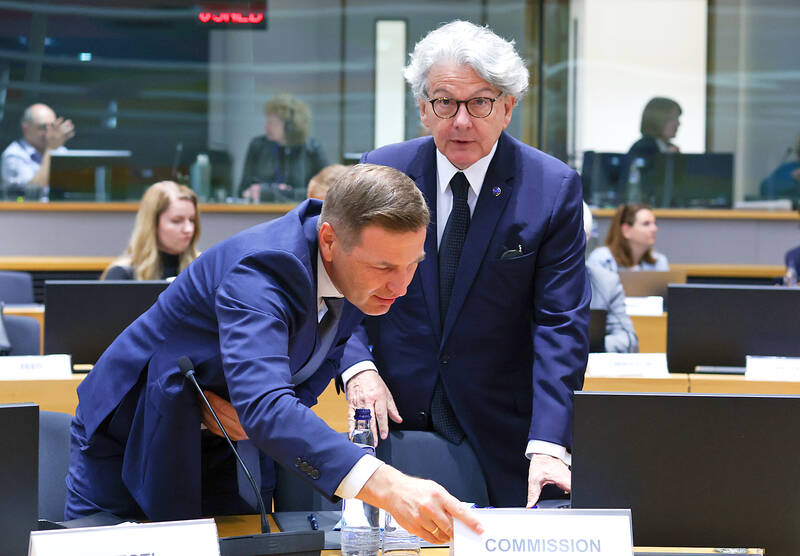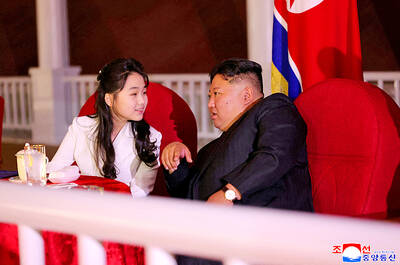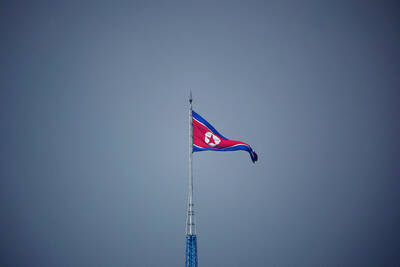EU defense ministers were yesterday debating whether to allow Ukraine to strike targets deeper inside Russian territory with weapons that have been sent by member states.
“I truly hope that all the countries that have these assets will also give permission to Ukraine,” Estonian Minister of Defense Hanno Pevkur told reporters, adding that Ukraine was already striking targets in Russian territory with its own drones.
“It cannot be normal that Russians are attacking from very deep into Ukrainian territory and Ukrainians are fighting with one hand behind their back,” Pevkur said.

Photo: EPA-EFE
Up to now, the US and Germany in particular have been cautious about sending weapons to Ukraine that would have the range to strike targets inside Russia because of the risk of a broader conflict.
After months of pleading from Ukraine, the US earlier this year sent long-range ATACMS missiles to Ukraine for use inside occupied territory.
Ukraine is struggling to defend the Kharkiv region from Russian air attacks, given its proximity to the border. Kyiv’s allies are shoring up efforts to send Ukraine more air defense assets, but striking targets inside Russia, where its attacks originate from, could help mitigate the cost of defending Ukrainian cities with expensive missiles to counter Russia’s significant supply of cheap bombs.
A Russian strike on a home-improvement superstore in Kharkiv on a busy shopping day last weekend killed at least 18 people and wounded several dozen.
Two days earlier, a Russian missile hit Ukraine’s largest publishing house, killing at least seven. Both attacks were launched from Russia’s Belgorod region, the Ukrainian military said.
Belgium yesterday pledged to deliver 30 F-16 jets to Ukraine by 2028, with the first expected to arrive this year.
“The weapons we deliver, as clearly stated in the agreement we signed, are meant to be used by the Ukrainian defense forces on Ukrainian territory,” Belgian Prime Minister Alexander de Croo told reporters.
Ukrainian President Volodymyr Zelenskiy visited Belgium to sign a security cooperation pact, and was set to visit Portugal later yesterday.
Zelenskiy hailed the deal with Belgium, saying in a post on X that the country is also delivering at least 977 million euros (US$1.06 billion) in military aid this year.
“We can’t, it’s a fact, risk the support from our partners, so we aren’t using the partners’ weapons against Russian territory,” he told a news conference in Brussels, adding that he was asking his allies to allow retaliatory strikes in Russia.
On Monday, NATO Secretary-General Jens Stoltenberg doubled down on his push to urge allies to lift restrictions on hitting targets in Russia.
“When we have delivered weapons to Ukraine it’s actually not ours anymore, it’s the Ukrainians’ and they have the right to self defense, including hitting legitimate military targets outside Ukraine and in Russia,” Stoltenberg told the NATO parliamentary assembly in Bulgaria.
EU High Representative for Foreign Affairs and Security Policy Josep Borrell said such a move is acceptable under international law, because Moscow’s attacks on Ukraine are originating inside Russian territory.
“The risk of escalation I’m sure will be put on the table by some, but you have to balance the risk of escalation and the need for Ukraine to defend” itself, he added, saying the current situation was “completely asymmetric.”
Defense ministers from Latvia and the Netherlands also expressed support for the idea.
Germany, meanwhile, is still holding back its Taurus system, citing concerns about the possibility for escalation and the need for German soldiers to operate the systems on the ground due to its unusually long range of more than 500km.
German Chancellor Olaf Scholz’s chief spokesman, Steffen Hebestreit, told reporters on Monday that a state under attack can generally defend itself with strikes against targets also outside its own borders. because this is in line with international law.
“And then it is always a question of the proportionality of the attack in question,” Hebestreit added.

‘HYANGDO’: A South Korean lawmaker said there was no credible evidence to support rumors that Kim Jong-un has a son with a disability or who is studying abroad South Korea’s spy agency yesterday said that North Korean leader Kim Jong-un’s daughter, Kim Ju-ae, who last week accompanied him on a high-profile visit to Beijing, is understood to be his recognized successor. The teenager drew global attention when she made her first official overseas trip with her father, as he met with Chinese President Xi Jinping (習近平) and Russian President Vladimir Putin. Analysts have long seen her as Kim’s likely successor, although some have suggested she has an older brother who is being secretly groomed as the next leader. The South Korean National Intelligence Service (NIS) “assesses that she [Kim Ju-ae]

In the week before his fatal shooting, right-wing US political activist Charlie Kirk cheered the boom of conservative young men in South Korea and warned about a “globalist menace” in Tokyo on his first speaking tour of Asia. Kirk, 31, who helped amplify US President Donald Trump’s agenda to young voters with often inflammatory rhetoric focused on issues such as gender and immigration, was shot in the neck on Wednesday at a speaking event at a Utah university. In Seoul on Friday last week, he spoke about how he “brought Trump to victory,” while addressing Build Up Korea 2025, a conservative conference

DEADLOCK: Putin has vowed to continue fighting unless Ukraine cedes more land, while talks have been paused with no immediate results expected, the Kremlin said Russia on Friday said that peace talks with Kyiv were on “pause” as Ukrainian President Volodymyr Zelenskiy warned that Russian President Vladimir Putin still wanted to capture the whole of Ukraine. Meanwhile, US President Donald Trump said that he was running out of patience with Putin, and the NATO alliance said it would bolster its eastern front after Russian drones were shot down in Polish airspace this week. The latest blow to faltering diplomacy came as Russia’s army staged major military drills with its key ally Belarus. Despite Trump forcing the warring sides to hold direct talks and hosting Putin in Alaska, there

North Korea has executed people for watching or distributing foreign television shows, including popular South Korean dramas, as part of an intensifying crackdown on personal freedoms, a UN human rights report said on Friday. Surveillance has grown more pervasive since 2014 with the help of new technologies, while punishments have become harsher — including the introduction of the death penalty for offences such as sharing foreign TV dramas, the report said. The curbs make North Korea the most restrictive country in the world, said the 14-page UN report, which was based on interviews with more than 300 witnesses and victims who had